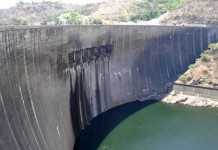In November 2012, Sino-Hydro, a Chinese firm, was contracted to construct two additional units at the Kariba Dam. The dam, which was constructed in the late 1950s, straddles the border between Zimbabwe and Zambia.
By 2014 the focus had shifted away from building extensions to a more immediate concern; that of a reported structural damage in the form of cracks in the wall. Shortly thereafter, Gilles Hervio, the EU Head of Delegation in Zambia traveled to Brussels where the situation was addressed as an urgent issue.
“Kariba Dam is a potential disaster …..I traveled to Brussels and by June and July, money will be released. We are studying it and no decision has been made yet but the amount involved could be between 85 million dollars and 100 million dollars,” he said.
The Zimbawe Situation
2015 has seen breaking news stressing that the 128 meter high wall could potentially collapse as the stilling pool below the gates is eroding under the dam wall itself.
Engineers, scientists, politicians and journalists worldwide have sprung a fountain of opinion and conflicting reports. For the average person sitting at home reading the newspaper, a long and boring set of statistics and probabilities brings to mind no mental image of the scale of such a disaster.
The stilling pool that is eroding lies deep and black and the thundering water that cascaded so violently through the wall has repeatedly dug out the base of the wall.
Every year millions of cubic meters of quick set concrete have been poured down to stop the force of the water eroding back under the wall; yet 81 meters of erosion have continued inexorably .
Beneath the foundations, in unimaginable darkness, the combined compressed pressures of rock and concrete and water maintain a steady force on the floor of the gorge: A gorge which which has experienced earth tremors of up to 5.5 on the richer scale in the past.
If the wall should fail catastrophically there will be an instant when the workers in the dam wall will see the needles on the pressure gauges leap into the red before their lives are extinguished.
The concrete could peel away in an instant, like bone under a band saw. Three hundred feet of water, a towering, massive pent up force of kinetic energy could thrust the great slabs of concrete away and explode to freedom in a mighty wave the height of the cliffs that bound it.
Imagine the devastation downstream if you can. It is almost too horrific to think to think of. The great Zambezi valley that lies below Kariba dam stretches flat and vast for thousands of square kilometers.
Below the dam wall at a place called Nyamomba, where the gorge ends and the flatlands of the valley proper begin, the water would spread out in a wall one hundred feet high.
Further downstream in Mozambique is yet another large dam called Cahora Bassa. There is thought to be a high probability that if Kariba dam breaks Cahora Bassa will also fail.Racing down the course of the river, the weight of the water would kick out the bottom of Cahora Bassa before the deluge even reached it.
See in your minds eye the workers and engineers downstream at Cahora Bassa Dam when the news is heard. Will they have the courage to remain on station and try desperately to lower the lake levels before the floodwaters from Kariba arrive?
It is not hard to envision the water race occurring. Wedge shaped as it follows the old channel of the river, the headwaters will rush to the fore of the visible wave.
Behind the Cahora Bassa dam wall, three hundred feet below the surface, the front of the wedge will find the obstruction and be forced up, curling back upon itself. Hundreds of millions of tons of water pressure will probe and poke at the base of the wall.
When the pressure becomes too much for the wall to bear,in an instant the bottom of the wall could kick out, in a massive explosion .
In all probability, if the Cahora Bassa wall breaks, the Cahora Bassa water would take off with the Kariba water riding on its shoulders. The Mozambican towns and cities of Tete, Tambara, Sena, Chinde, Quelimane and Beira could be wiped off the face of the earth before the floods plunge into the Indian Ocean.
Some experts even think the impact on the ocean would cause tidal waves in India.
Mana Pools World Heritage site sandwiched between the Kariba dam and the Cahorra Bassa, on the ancient riverbed of the Zambezi River, would be swept away and millions of animals would be lost as their sanctuary is devastated. The waters would devour up the lowlands, churning and heaving, drenching and drowning the vast wilderness.
In Zambia, the waters could back-flood via the Kafue into the Lusaka province where the Capital City of Zambia is surrounded by dense populations. The disaster would have to be managed with no electricity as the power source of the country will have been destroyed.
Kariba Dam was designed by the French engineer Andre Coyne who was considered a specialist in arch dams. He personally designed over 55 dams, Kariba being one of them.
Zambia Tourism
Andre also designed the Malpasset Dam in Southern France. On December 2, 1959, the dam broke and the resulting 50 meter high wall of water that reached the town of Fréjus killed an estimated 421 people. Coyne died soon after the incident – some say from a broken heart.
Malpasset Dam was the sixth arch dam to fail since the 1926 Vaghn Creek dam disaster in the USA. Foundation defects account for the failure of half of those six arch dams.
Catastrophic dam failure is completely possible. Kariba, like any other dam in the world has the capacity to fail. If the unthinkable happens, the failure would be the worlds largest and most devastaing. The Banqiao Reservoir Dam, located on the River Ru in the Zhumadian Prefecture of the Chinese Henan province, currently holds this dubious record. It failed in 1975, killing an estimated 171,000 people and destroyed the homes of 11 million people.
Are the above descriptions far-fetched? Could it really happen as described in this story? I guess the answer would be that nobody really knows: until it happens.

 JOIN DRIVERN TAXI AS PARTNER DRIVER TODAY!
JOIN DRIVERN TAXI AS PARTNER DRIVER TODAY!












It’s better to prepare for the worst and hope for the best.